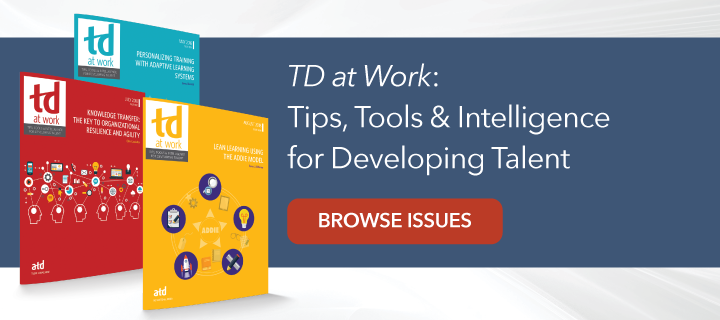How much do learners remember from your training courses? Would you like to help them retain more and help yourself as an L&D professional at the same time? If so, Dana Alan Koch offers some guidance in “Principles for Brain-Friendly Learning.”
Based on research about the neuroscience of learning, how to make learning stick, and other related learning science topics, Koch and the team at Accenture’s Institute for the Applied Learning Sciences note eight principles to make learning more durable.
Principles Behind Durable Learning
Learning is at its best when it is “relevant, contextual, engaging, effortful, generative, social, spaced, and reflective,” writes Koch.When learning is relevant, it’s important to learners. It’s something they want to pay attention to because they see it as beneficial to them. That may be because it helps them in their everyday routine, or it may help them advance to a new position. When designing learning, consider whether the training has real-world applicability to learners.
L&D leaders understand that engaging learning generally doesn’t involve a facilitator reading off a PowerPoint slide. Rather, training may involve small group discussions, experiential learning, and breaks that allow learners to get up and move. In determining whether your learning is engaging, ask yourself if the course includes several different modalities and whether it factors in the 20-minute neurological limit on the human attention span.
Koch describes the reflective principle as synthesizing experiences or new learning; it involves “moments of thoughtful sensemaking.” Reflection activates the brain’s retrieval, articulation, and elaboration processes. Does your training build in time for learners to reflect on what they’ve learned? Do you provide tools for learners to use, such as a learning journal or a job aid with prompts?
No learning is going to be 100 percent durable. But incorporating these principles into a training program will give learners an advantage.
Learn to Learn Model
Beyond the intentional design of training and development initiatives, learners need to be ready and equipped to learn. As Koch writes, “There is a relationship between the learner’s ability to learn and a designer’s ability to design and deliver brain-friendly learning.”Consider three processes that our brain’s neurons and pathways actively engage in when we learn: intake, encode, and retrieve.
- Intake. We receive new information daily through our senses. Our prefrontal cortex decides what is important and worth focusing on.
- Encode. Once the brain understands that what it’s receiving is important, the memory types—working, storage, and retrieval—come into play. A person makes connections with what they already know, expands on it, and indexes it so it can be easier to find.
- Retrieve. This is the process of “pulling knowledge out of long-term memory so learners can either apply it directly or use it in their working memory to expand and grow,” writes Koch.
There are, however, barriers to these processes operating at peak efficiency. But some things can aid the brain. Elements that Koch describes as learning accelerators include exercise, nutrition, stress management, and sleep.
These accelerators are why it’s important for L&D leaders to provide healthy snacks when appropriate; make sure that there is the right amount of cognitive load and not too much; and give learners a chance to get up and move.
As learners ourselves, we can get adequate sleep—seven to nine hours is considered optimal—eat well, and get up from our desks and incorporate exercise into our routines.




